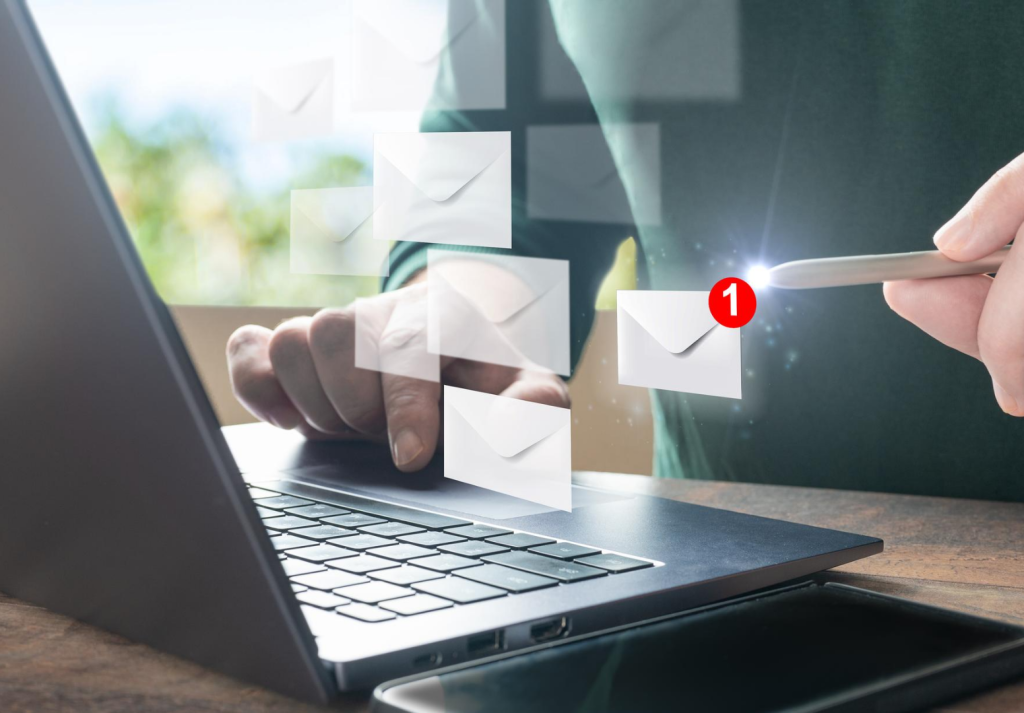
Introduction
In times where global email are projected to reach 4.73 billion by 2026, email marketing can significantly enhance Return on Investment (ROI) for businesses. It offers a cost-effective means of reaching a targeted audience with personalized content. This targeting can boost engagement and conversion rates, translating into a higher Return On Investment (ROI). Moreover, email marketing provides automation capabilities, enabling the creation of automated campaigns that nurture leads and drive sales, all with minimal manual intervention.

Email marketing is not just about one-time transactions; it’s a tool for building long-term customer relationships. Consistent, non-intrusive communication through email helps build trust and loyalty, leading to repeat business and referrals. The scalability of email marketing is also worth noting – it can accommodate businesses of various sizes and grow with them. Combining cost-effectiveness, targeted communication, automation, data analytics, relationship building, and scalability makes email marketing potent for enhancing Return On Investment (ROI) in a business’s marketing strategy.
Predictive Analytics for Email Timing:
In the world of email marketing, where 333 billion emails are exchanged daily, timing is everything. Sending an email at the right moment can differentiate between being opened and acted upon or languishing in the recipient’s inbox. It is where predictive analytics steps in, revolutionizing the email marketing landscape.

Predictive analytics involves harnessing the power of data and algorithms to predict when your target audience is most likely to engage with their emails. It considers various factors, including historical data, recipient behavior patterns, and external events. By analyzing this data, predictive analytics can pinpoint the optimal times and days for sending your emails.
The significance of this approach cannot be overstated. Sending emails when your audience is most receptive ensures that your message doesn’t get lost in a crowded inbox. It increases the likelihood of the recipient opening, reading, and taking action based on the content. As a result, the Return On Investment (ROI) of your email marketing campaigns is significantly enhanced.
Predictive analytics empowers businesses to deliver the right content to the right people at the right time, ultimately leading to higher engagement and conversion rates. It’s a data-driven strategy that maximizes the impact of your email marketing efforts and exemplifies the dynamic and evolving nature of this essential digital marketing tool.
Behavioral Triggers and Email Personalization:
In email marketing, the power of personalization cannot be overstated. It goes beyond addressing recipients by their first name; it’s about understanding their behavior and preferences to create emails that resonate on a deeply individual level. It enhances the customer experience and drives higher Return On Investment (ROI) by converting email interactions into tangible results.

Behavioral triggers involve setting up automated responses based on how recipients interact with your emails and website. For instance, an email reminder can be triggered if a customer abandons their shopping cart, enticing them to complete the purchase. Conversely, personalization tailors the email content to the recipient’s specific interests and past behaviors. By fusing these techniques, email marketers can craft highly relevant, timely, and personalized messages.
The implications for Return On Investment (ROI) are substantial. Personalized, behavior-triggered emails enjoy significantly higher open and conversion rates than generic, one-size-fits-all communications. When recipients receive content that aligns with their preferences and behaviors, they are more likely to engage and take the desired action, whether making a purchase, signing up for a webinar, or subscribing to a newsletter.
Email Marketing for Upselling and Cross-Selling:
The global email marketing market was worth $7.5 billion, with a projected increase to $17.9 billion by 2027. Email marketing is a versatile and valuable tool for businesses looking to boost sales and Return On Investment (ROI), especially when upselling and cross-selling to their existing customer base. These strategies focus on encouraging customers to purchase additional products or services, and when executed effectively, they can profoundly impact a company’s bottom line.
To excel in this realm, businesses must employ various tactics and strategies. For upselling, emails can highlight premium or upgraded versions of products the customer has previously purchased. It adds value to the customer and increases the average transaction value, thus improving Return On Investment (ROI). Conversely, cross-selling involves suggesting complementary products or services that align with the customer’s past purchases. Email marketing can effectively convey these suggestions, expanding the customer’s shopping cart and driving additional revenue.
Furthermore, it’s crucial to craft compelling and persuasive email content communicating the benefits of the upsell or cross-sell. This content should be personalized, showcasing an understanding of the customer’s needs and preferences. Timing is also critical; sending these emails at the right moment in the customer’s journey can significantly impact their decision-making.
In crux, email marketing is a potent ally for businesses seeking to maximize their RETURN ON INVESTMENT (ROI) through upselling and cross-selling strategies. It empowers companies to engage with existing customers, drive additional sales, and enhance the overall customer experience, ultimately leading to increased profitability.
Interactive Emails and Gamification:
Email marketing has evolved, introducing innovative techniques like interactive emails and gamification that breathe new life into campaigns. These methods transcend traditional static email content, captivating users’ attention and cultivating an immersive, enjoyable email experience that enhances engagement and ultimately boosts Return On Investment (ROI).
Interactive emails take the static out of emails by incorporating dynamic elements such as image carousels, accordions, and embedded videos. These features encourage recipients to engage with the email, creating a memorable experience actively. Gamification, on the other hand, infuses an element of fun and challenge into emails by incorporating games, quizzes, or contests. These interactive and playful components not only entertain but also incentivize user participation.
The profound impact on Return On Investment (ROI) stems from increased engagement and click-through rates. Interactive emails and gamification pique recipients’ curiosity and keep them within the email for longer. This extended engagement often leads to higher conversion rates, whether purchasing, signing up for a newsletter, or sharing the email with others.
Additionally, these techniques enhance brand perception and customer loyalty by providing a unique and enjoyable experience. Subscribers are more likely to remember and return to engaging brands. Ultimately, interactive emails and gamification are transformational tools for email marketing, reshaping how businesses connect with their audience and significantly improving the RETURN ON INVESTMENT (ROI) of their campaigns.
Post-Purchase Email Strategies:
Post-purchase email strategies hold a pivotal role in the world of email marketing. Beyond the initial sale, these strategies are integral to customer retention and fostering repeat business. They enable businesses to maintain valuable relationships with their existing customer base, ultimately driving increased revenue and Return On Investment (ROI).
The primary objective of post-purchase email strategies is to nurture the customer relationship. Once a customer has made a purchase, they must be engaged and satisfied. Through well-timed and personalized post-purchase emails, businesses can express gratitude for the purchase, provide order updates, and request feedback on the customer’s experience. These interactions demonstrate care and appreciation and offer opportunities for upselling, cross-selling, or promoting related products or services.
Furthermore, post-purchase emails can be instrumental in enhancing brand loyalty. By keeping customers informed about upcoming promotions, exclusive offers, or relevant content, businesses can encourage repeat purchases and maintain their brand top-of-mind. Recommendations based on the customer’s previous purchases or browsing history can pique their interest and lead to additional transactions.
Conclusion
Email marketing is a proven Return On Investment (ROI) booster, a strategy every business should invest in. Why? It’s cost-effective, allowing even small businesses to reach a wide audience without breaking the bank. Moreover, email marketing offers unparalleled targeting capabilities, allowing you to send personalized content to specific audience segments. This relevance leads to higher engagement and conversion rates, which, in turn, boosts Return On Investment (ROI).
The beauty of email marketing lies in its versatility. It can be tailored to fit various business goals, from lead nurturing to customer retention and upselling. You can continually refine your strategies by analyzing campaign performance for better results.
Don’t underestimate the power of email in building long-term customer relationships. It’s a non-intrusive, consistent communication channel that fosters trust and loyalty, resulting in repeat business and referrals. In a digital age where attention spans are short, email marketing offers a direct line to your audience, making it a cornerstone of a successful marketing strategy that no business should overlook.
FAQs
Q. Metrics to track the Return On Investment (ROI) of email marketing efforts?
A. Metrics to track the Return On Investment (ROI) of email marketing efforts include open rates, click-through rates, conversion rates, and the overall revenue generated from email campaigns.
Q. How do I get started with email marketing for my business?
A. To get started with email marketing for your business, select a reputable email marketing platform, build an opt-in email list, and create engaging, relevant content to send to your subscribers.
Q. How do you build and segment the email list effectively?
A. Building and segmenting an email list effectively involves collecting quality leads, categorizing subscribers based on their preferences and behaviors, and sending targeted content to each segment for improved engagement and Return On Investment (ROI).




